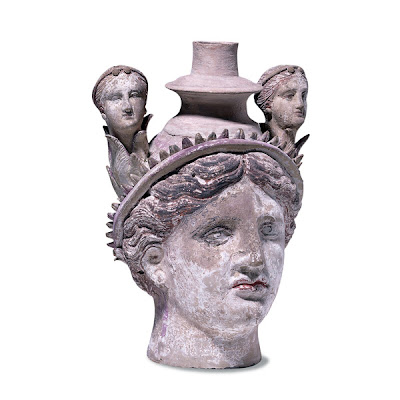


I'd first seen examples of Canosa pottery at the British Museum a few years ago and was completely astounded. These particular types of vases were frequently made to be placed inside tombs, thus never intended to be functional, and it seems that gave their makers license to go bonkers. Sometimes called "magenta ware" because of the strident pink and purple coloring, Canosa pottery is garish, outlandish, loud. Seemingly bizarre conglomerations of heads, figures, spouts, and horses, they are completely antithetical to the supposed ideal of ancient Classicism.
I like that early Classical scholars seemed to be embarrassed by them:
From Canosa, a city near the east coast, north of Brindisi, have come a series of vases which the most ambitious endeavours have been made to decorate with figures, the result, however, being altogether unsatisfactory. Examples...[are]...mixed and confounded in an almost ludicrous fashion.–Marcus Bourne Huish Greek Terra-cotta Statuettes 1900It occurred to me that these were likely made by local craftsmen extemporizing on a known theme—riffing— rather than artists creating to a traditional standard. Perhaps like the gravestone carving of colonial New England they're folk art interpretations, each potter adding and altering the form as he saw fit. Like Classical Outsider Art.
From an earlier post, and some other favorites:
Another thing I never truly noticed before was how mutable form was for the Greeks and Romans et al.This flies in the face of the measured, symmetrical rationality that supposedly defines the Greeks. Double-faced ("janiform") heads, heads split down the center, human figures sprouting horses, extra heads or an accretion of limbs. Vases in the shape of legs, heads, phalluses, birds, even lobster claws... It's as though corporeal form, for them, was a transient state: often recorded, in bronze or terra cotta, in mid-transformation...










4 comments:
Your blog is fabulous, I adore reading it! You make some truly excellent observations! It's interesting how these decorative objects had a pretense of being "functional" rather than mere statues or figurines, as common in other burial practices. Maybe it was an example of contained creativity, in contrast to the measured and ordered architecture, as you said.
Thank you for the wonderful comment!
The characterization of Classical art that persists is: white, serene, measured--these are all so raucous, and oddly...full of vitality –considering the Canosa ware is funerary.
Fascinating and exquisite Angela....these pieces... and your blog.
New to blogging I just discovered your site recently and am including it on my favourites. I hope you have relocated happily if that indeed happened. i shall very much look forward to future posts from you down under in OZ (Australia)!
Post a Comment